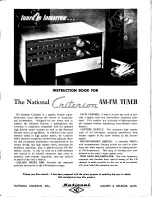
Rev B
18
other frequencies, review the frequencies you have just entered (using the delete
option), or press
ESC
to leave the menu of
FTABLE
. If you run into trouble, press the
ESC
key repeatedly
until you are back to the main menu (frequency and gain display), and then start
over.
When you have created your frequency tables you will set the scan (or dwell) time. This is the
amount of time the receiver will stay at each frequency in the scan table before proceeding to the
next frequency. You can choose this time in hundredth of a second intervals over a range of 1
second to 10 minutes.
PROCEDURE: SETTING SCAN TIME
From the command environment, press
SHIFT SET SCAN
The screen will prompt you to enter a 5 digit number (minutes:seconds.
hundredths); the colon and decimal point are automatically supplied. Normally
you will select a scan time that is (at least 100 msec.) longer than the longest pulse
interval of your transmitters to ensure that no signals are missed. For example,
Enter 0:10.50 for 10.5 seconds
Enter 1:23.00 for 1 minute, 23 seconds, etc.
NOTE: All digits must be entered. After the last digit is entered, the receiver will automatically
return to the command environment display (frequency and gain) with the addition of scan time
in the lower left quadrant. The arrow keys will now adjust the scan time using the time
increment selected by the
SET
∆
function.
Since you will be flying, you will be concerned about the levels of noise generated by the
aircraft engine and how this will affect your receiver sensitivity. Your first flight is in fact
dedicated to setting up your antennas and establishing a "noise floor", using one or more
reference transmitters in a known location on the ground. While flying, you will use the
SIGNAL
/Interval
routine to assess the level of noise.
PROCEDURE: NOISE AND SIGNAL MEASUREMENTS
The
SIGNAL
key controls the SRX_400's pulse interval and signal strength
measurement functions. All of these functions except
Power Graph
are also
available in the
SCAN
environment. This example illustrates the use of
SIGNAL
functions for a single frequency.
First, from the command environment, set a frequency using the
SHIFT +
SET F
key
sequence, with appropriate five or six digit data entry. Then press
SHIFT SIGNAL
and, at the menu, press 2 to select the
Interval
routine.
















































